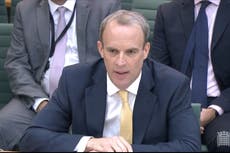School spending set to remain below 2010 levels – as poorest areas ‘hammered’ by biggest cuts
Funding ‘runs counter’ to aim of levelling up poorest parts of the country, says IFS

School spending per pupil in England will remain lower than in 2010 following a decade of education budget cuts, new research has revealed.
Boris Johnson’s government has committed extra £7.1bn funding for schools in England for 2022-2023 – but it will not reverse a cut in real-term spending per pupil over the past decade, according to the Institute of Fiscal Studies (IFS).
Total school spending per pupil in England was just over £6,500 in the latest complete year of data in 2019-20, some 9 per cent lower in real terms than its high-point of £7,200 in 2009-10, meaning spending will still be 1 per cent lower than a decade ago after accounting for inflation.
The think tank also said disadvantaged pupils in the poorest parts of England have suffered from the biggest cuts over the decade of austerity, and its research shows they are now receiving the smallest increase in extra spending.
Between 2017–18 and 2022–23, funding allocated for the most privileged schools will increase by 8 to 9 per cent in real terms, compared with only 5 per cent for the most deprived schools.
Labour said Conservative cuts have “hammered” school budgets over the last decade and accused the government of “stripping away” children’s opportunities.
The opposition urged ministers to invest more in post-Covid catch-up funding, as House of Commons library data showed the UK has outstripped most European countries in the length of time schools were closed for during the pandemic.
Luke Sibieta, research fellow at IFS, said the “big squeeze” in school spending per pupil in England was the largest in at least 40 years.
“This will make it that much harder for schools to address the major challenge of helping pupils catch up on lost learning alongside everything else they are required to do,” he said.
The IFS expert added: “Schools serving disadvantaged communities face the biggest challenges. They faced the biggest cuts up to 2019 and are now receiving the smallest rises. This pattern runs counter to the government’s aim of levelling up poorer parts of the country.”
Josh Hillman, director of education at the Nuffield Foundation, the charitable trust which commissioned the research, added: “It is crucial that schools in deprived areas receive appropriate and well-directed funding so that they can help to close the disadvantage gap and ensure all children can reach their potential.”
Kate Green, the shadow education secretary, said the IFS report showed how “Conservative cuts have hammered school budgets over the last decade”.
The Labour frontbencher added: “Children’s opportunities have been stripped away as class sizes have soared to record levels and enriching extracurricular activities have been cut back.”
Since the start of last year children in the UK have been out of class on nearly half (44 per cent) of days – amounting to longer school closures than any European country except Italy.
The shadow education secretary said the long stretches pupils spent out of school was partly the fault of failures by education secretary Gavin Williamson.
“The Conservatives’ failure to respond to the Covid crisis has kept kids out of class for far longer than their European counterparts,” said Ms Green – calling on the government to make sure proper ventilation is in place so Covid outbreaks can be minimised this autumn.
“As the new school year starts, Gavin Williamson is again burying his head in the sand, ignoring the advice of scientific experts and risking creating a climate of chaos for schools if Covid rates rise,” she added.
A Department for Education (DfE) spokesperson said the £7.1bn increase in funding for schools, compared to 2019-20 funding levels was “the biggest uplift to school funding in a decade”.
The DfE added: “Next year, funding is increasing by 3.2 per cent overall, and by 2.8 per cent per pupil, compared to 2021-22. The National Funding Formula continues to distribute this fairly, based on the needs of schools and their pupil cohorts.”
Join our commenting forum
Join thought-provoking conversations, follow other Independent readers and see their replies
Comments


Bookmark popover
Removed from bookmarks